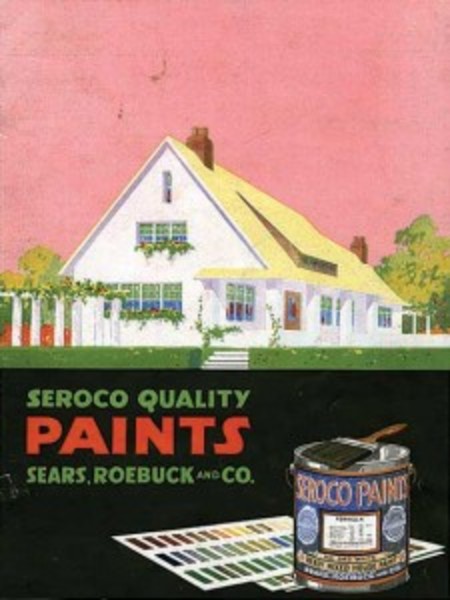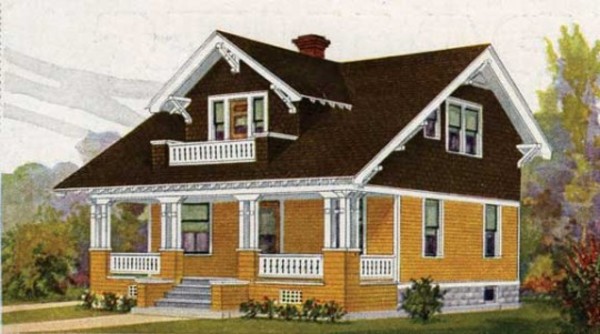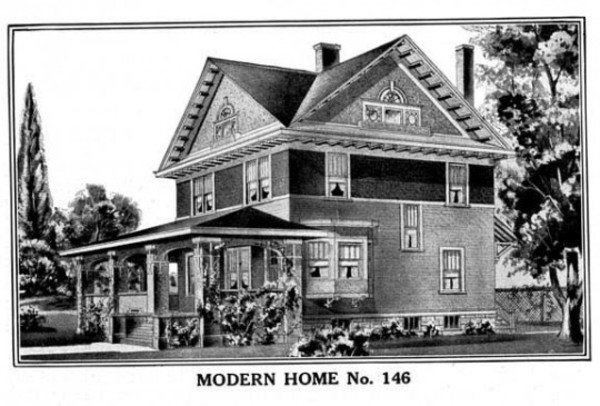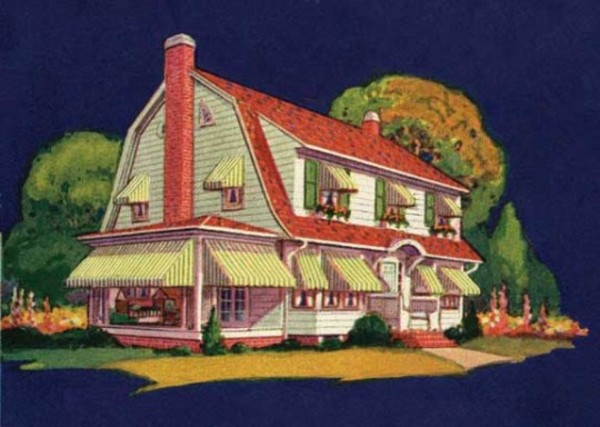
Seroco paints catalogs from Sears outlined color schemes for all of the company’s mail-order houses. (All illustrations from the collection of John Crosby Freeman)
Many homes built in early 20th-century subdivisions were ordered from catalogs and delivered “ready-cut” in boxcars to be assembled on site. While several companies actively sold such prefabricated or “kit” homes, those supplied by Sears-Roebuck remain the most famous. Beginning in 1908, their “Modern Homes” division offered building plans, materials, and kit houses shipped by rail to every corner of the United States.
These houses—produced into the 1930s—consisted of a few styles with many variations. One of the ways the homes could be customized was through their paint schemes, a fact that Sears capitalized upon with their own Seroco line of paints (from Sears Roebuck Company), which was promoted in separate catalogs. Through the years, individual Sears house designs came and went—but their Seroco colors remained constant. I’ve matched the original colors documented in rare Seroco catalogs with today’s extensive line of Sherwin-Williams paints. Since the original Seroco colors suggested for these five top-selling Sears houses are a bit bold for today’s tamer color sensibilities, I’ve lightened those palettes. All of these classic exterior Sears paint colors are suitable for a range of old houses dating to the early 20th century.
Here’s a rundown of popular Sears paint colors for kit houses.
The Westly (Modern Home No. 144)

In today’s post-modern era, Americans are more confused than ever about the meaning of the word “modern.” Stripped of architectural valuations, “modern” simply means “of today.” It was in this context that Sears identified the Westly model as “Modern Home No. 144.” While real-estate rhetoric of the period could be intoxicating, Sears soberly described the Westly in 1927 as “a high grade two-story house, retaining the architectural beauty of a modern bungalow. Built everywhere.” Surviving from 1911-1929, it was Sears’ all-time most popular house.
The Westly is a classic American Arts & Crafts bungalow that symbolically marries elements of America’s two colonial architectures. Early Colonial of the 17th century is represented in both the brown weathered wood shakes on the second story and a New England Saltbox roofline turned back-to-front over a full-width recessed veranda. Georgian Colonial of the 18th century is represented, too, in first-floor clapboard siding painted Seroco’s Colonial Yellow.
The primary virtue of this illustration of the Westly from a 1920s Seroco catalog is shock value. Recent tsunamis of bland architectural off-whites have ruined America’s rich legacy of contrasting exterior colors, such as the saturated yellow ochre of Colonial Yellow. Although this original color is very close to Sherwin-Williams Gold Crest, today’s debilitated color sensibility isn’t up for living with it or the other bold Seroco shades in this original illustration (Leather Brown, Cream, and Maroon). Instead, I’ve substituted the weaker tint of Sunrise in my new prescription for colors and placements.

- First-floor clapboards: Sunrise
- Gable; foundation; veranda apron, piers, and floor; door casing: Mocha
- Windows: Jersey Cream
- Cornices, rafter tails, angle brackets, belt course, corner boards, foundation and fascia boards, pillars, rails, doors: Arresting Auburn
- Eaves, balusters: Glamour
- Veranda ceiling: White Truffle
Modern Home No. 105

Here’s an inconvenient truth about America’s early 20th-century mass-marketed domestic architecture—old styles remained popular many years after they ceased being fashionable. Modern Home No. 105, from the back cover of the 1908 Seroco catalog, is a 19th-century classical vernacular homestead retaining popular late Victorian veranda and gable peak ornament. (Similar turned columns, angle brackets, and cornice drapery were available through millwork catalogs until World War I.) This house got a facelift in 1910, losing its gingerbread and gaining a neoclassical Colonial Revival veranda, but its homestead style survived.

The original Seroco Terra Cotta walls and trim in Pearl and Myrtle Green make a bold statement. The following prescription is based on tints in the same palette, reduced in intensity.
- Roof: Tile Red asphalt
- Siding: Folksy Gold
- Cornices, corner boards, angle brackets, rails: Jadite
- Eaves, railing spindles: Kind Green
- Windows, veranda ceiling: Creamery
- Veranda, doors, foundation boards, gable ornament: Isle of Pines
- Foundation, veranda floor, fascia boards, stairs, door casing: Sawdust
Modern Homes No. 111 & 146


These two houses, both examples of square-type homes but with different stylistic flourishes, can be painted in similar schemes. Modern Home No. 111 (top), also from the back cover of the 1908 catalog, is a progressive descendant of the Victorian Italianate, minus the bracketed cornices. It retains its Late Victorian parfait layers of different wall coverings, with uncommon stucco down and clapboard up. These square-type houses, as they were called, drew attention to the economy of a square plan having the highest ratio of usable space to outer walls, other than an octagon or circle. In 1918, the latent Victorian paneled pedestals below the veranda columns were replaced with full-length Colonial Revival columns.
The popular name for Modern Home No. 146 (bottom), a more stylish square-type design, was Shirtwaist House. Light-colored lower clapboard walls compress darker shingles on the second floor by rising to windowsills laterally extended as a belt course. Modern Home No. 146, the lead house in the 1910 catalog, was a robust mélange of Arts & Crafts and Colonial Revival details (note the over-scaled keystones in the third-floor Palladian windows).

While No. 146’s sketch is in black & white, the Seroco catalog suggested a palette of Colonial Yellow stucco, Beaver Brown clapboards, and trim in Willow Green and Buff, illustrated on 111. Based on these originals, I suggest the following.
- Roof: Gray shingles
- Stucco walls: Harvester
- Clapboards, railing spindles, pedestal panels, cornice eaves: Ryegrass
- Cornices, corner boards, belt course, foundation boards, veranda (except panels), doors: Basque Green
- Foundation, rails, stairs, veranda floor, fascia boards, door casings, dormers: High Tea
- Windows: Vanillin
- Veranda ceiling: Celery
The Verona

Illustrations in early Seroco catalogs showing and specifying colors quickly disappeared. Black-and-white pictures in Sears architectural catalogs only reveal lighter and darker parts. The Verona appears in the 1927 catalog in color only to promote the savings Sears’ houses offered without an architect’s fee (“from $100 to $1,000”).

The Verona is a Colonial Revival, three-bay, central entrance, two-story classical vernacular homestead masquerading as a side-gabled Dutch Colonial. The Verona’s colorless walls cry out for contrasting colors, but to protect those with faint hearts not up to the Viagra of vivid colors, I’ve selected a conservative, classic gray color scheme rooted in Seroco’s Slate and French Gray, with green and red accents. Flower boxes help draw attention away from the roof, and awning stripes would traditionally repeat the roof color.
- Roof: Dark gray shingles
- Lower walls: Gray Area
- Dormer walls: Unusual Gray
- Roofline trim, door casing: Web Gray
- Windows, side veranda : Navajo White
- Shutters, flower boxes: Shamrock
- Doors, stoop brackets: Fireweed
Online Exclusive: Download a chart of all Seroco/Sherwin-Williams color matches.
See Choosing Victorian Exterior Paint Colors for more inspiration.







